7
DEALING WITH CONFLICT
This final group of designs will provide a variety of tools for dealing with individual or team conflict. In conflict situations, trust is compromised in some way. These designs therefore require very little trust from the participants. In fact, two of the designs can be used in situations where zero trust exists. The other two designs require teams that have some low level of trust, so they can be used in most situations.
Conflict can sometimes arise unexpectedly, so two of our designs can be run as emergencies—where the facilitator decides in the moment that there is conflict that needs to be dealt with. They require no preparation and can be done in as little as 30 minutes.
Again, take time to familiarize yourself with all the designs and their individual nuances before you decide which to use for your team.
The 8 and 6
The 8 and 6 (Figure 7-1) is a powerful design for resolving conflict between two people, while at the same time building a more positive and constructive relationship between them. It works because it engages the participants in a highly structured process that ensures equal risk.
Figure 7-1. The 8 and 6
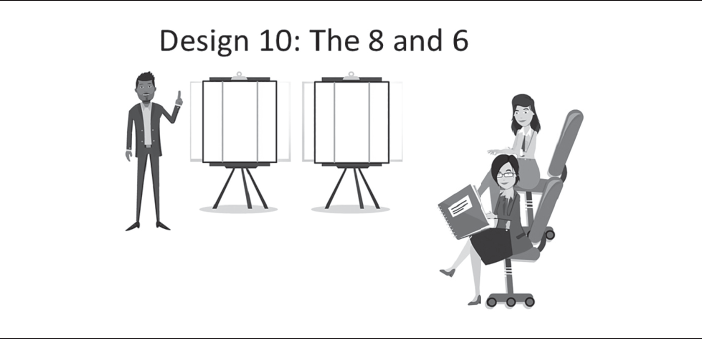
There are a couple of assumptions that need to be satisfied before choosing this design. First, the two conflicting parties need to be committed to resolving the conflict. This could be because they believe their current situation must change, or because they have been told to fix it or else. Second, the third-party facilitator (you) is trusted by both individuals to at least be a fair referee in the process.
Step 1: The Setup
Schedule at least a half day for this design in a neutral, off-site location. If an off-site location isn’t possible, make sure to choose a soundproof office location that doesn’t indicate a preference for one individual over the other, or doesn’t have windows through which people can be seen. Some people want instant resolution and see a half day spent with people in conflict as rather onerous. If this happens, you might want to point out to them the cost to the team or organization in terms of productivity and morale if the conflict were to continue, and how their conflict bleeds into other relationships and functions.
You’ll need to prepare a notebook and pen for each of the two people, some large sheets of flipchart paper, two easels, markers, and masking tape. Set up the room with the easels facing away from each other (Figure 7-2). This is just to give the two people some privacy for writing.
Step 2: The Information Gathering
Initially tell the two people that they will each be stationed at their own easel containing flipchart paper. When they get to their easels, ask them to split the top sheet into three equal parts by drawing two vertical lines on the page. Then ask them to label the left and right columns with “My Strengths” and “They Will Say,” respectively (Figure 7-3).
Figure 7-2. The Setup

Explain that the left column should contain their own eight greatest behavioral strengths as a person, leader, or team member. The right column should contain what they believe the other person will say are their eight greatest strengths. The rule is that each person must write eight items in each column and be able to provide a behavioral example of each strength. This means an example of something that they do that demonstrates the strength, which other people can observe. The assumption is that even enemies or those in conflict have many strengths, or they wouldn’t be working in the organization.
Once they finish this task, ask them to write in their notebooks the other person’s eight greatest strengths. It is important to make sure the participants each write eight things even if they seem incapable of listing this many. Much of the time the underlying reason for any resistance is that the conflict they are trying to resolve has them stuck in the other person being wrong, and they cannot think of anything good to say about them. Forcing them to list all eight provides a means of beginning to break down these entrenched feelings, without which the conflict will never be resolved. If you work with somebody, you should be able to find at least eight good things to say about them—even if some ideas are a bit lame. As facilitator, you can also encourage the participant to think of the other person outside of work, such as saying they’re a great parent. But, the key is that they must believe this is true.
| TOP TIP | Set the tone of the meeting by saying something like, “We will not be talking about history.” This will ensure that you avoid getting into a “he said, she said” blaming discussion that would further polarize the combatants and be nearly impossible to facilitate. |
Figure 7-3. Strengths

Step 3: The Strength Sharing
Ask the two people to fold over their sheets as shown in Figure 7-4, then bring their easels to the middle of the room. These folds cover the text on each end of the sheets and leave the blank center column visible. Now ask for a volunteer to go first. If nobody volunteers, choose one. Because there is often a power difference between the two people, we’ll usually have the subordinate person go first in giving strength-based feedback. Then, later, when they give feedback on areas of development, we have them go second, reducing the stress on the person with less authority.
| TOP TIP | If one of the people is the boss, have the subordinate first give the boss feedback on their strengths. When focusing on areas of development, have the boss give their areas of development first. We’re assuming it’s easier to receive feedback from the boss than to give it to them. |
Figure 7-4. Paper Folds

Ask the person going first to stand next to their easel, while you and the other person sit down in a chair in front of them. Ask the person now sitting next to you to read out the other person’s strengths one at a time, from their notebook. As they do this, the person standing will write these strengths down in the empty center column of their sheet (Figure 7-5). Remember, each piece of feedback should be accompanied with at least one specific example. The person receiving the feedback can ask clarifying questions, but cannot disagree with the information being provided.
It’s critical that the person providing the feedback be able to give an example or two of each strength as they are reading them out. The facilitator is also expected to add their own examples as needed to the growing list of behavioral strengths. When we are in conflict, adversaries rarely focus on each other’s strengths, so this can be somewhat uncomfortable as well as enlightening.
Figure 7-5. Filling in the Center Column: Strengths
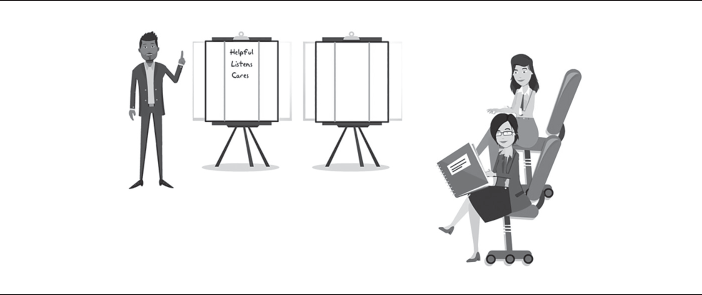
The next stage is to ask the person to unfold their left column and reveal their assessment of their own strengths. They present their eight items one by one, again giving examples for each. Then, they unfold their right column to reveal what they thought the other person—their adversary—would say (Figure 7-6).
Figure 7-6. Revealing Left and Right Columns
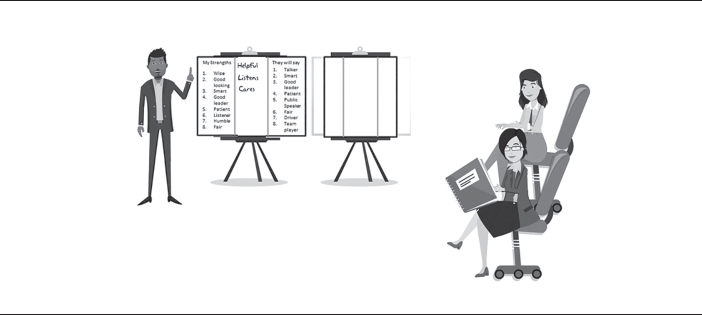
Suddenly there’s a lot of information; the facilitator should explore agreements and discrepancies and encourage a good discussion about them. Try to limit any talk about overusing strengths at this point; this will be discussed later when areas of development are explored. The goal here is to have the two people recognize that there’s more to the situation than a trail of negatives by first building a full picture of each other’s strengths. It is usually remarkable how much agreement there is between the strengths recognized by the individual and those from the individual providing the feedback. There can be some differences when it comes to what the receiver thinks the other will say, because the conflict itself can influence how the person thinks they are seen by the other.
The process so far will often take more than an hour to complete, so after a 10-minute break, the second person stands before their easel and the same process occurs, focusing first on feedback from the other person, then comparing that with the individual’s view of their strengths, and finally looking together at what the second individual thought would be said. The analysis of similarities and differences often leads to laughter and surprise, which can greatly lighten the mood between two adversaries.
Step 4: The Development
Now ask the two people to return to their easels. Once there, they divide a second sheet of flipchart paper into three columns, this time focusing on areas for development. The left column will contain what the individual believes are the six areas of development needed for them to become a more effective leader, colleague, or team member. The right column will reflect what they believe the other individual will identify as their six areas of needed development (Figure 7-7). And finally, they should write in their notebooks the development areas they see for the other person.
Figure 7-7. Areas for Development

Once they’re finished, repeat the process of having each one stand next to their easel, while you and the other person sit in front of them. The person sitting next to you reads out the other person’s areas for development from their notebook. The person standing will write them down in the center column of their sheet (Figure 7-8).
Go through the sharing process once again with both people. At the end, explore the agreements and discrepancies and encourage a good discussion about them. As mentioned previously, often problems between two people are generated by one individual “overusing” their strengths. For example, an assertive person can become aggressive, even tyrannical, and because people don’t want to take them on, over time this behavior is reinforced and becomes negative. Most of us have overused strengths in our repertoires. The facilitator must help people understand this.
Figure 7-8. Filling in the Center Column: Areas for Development
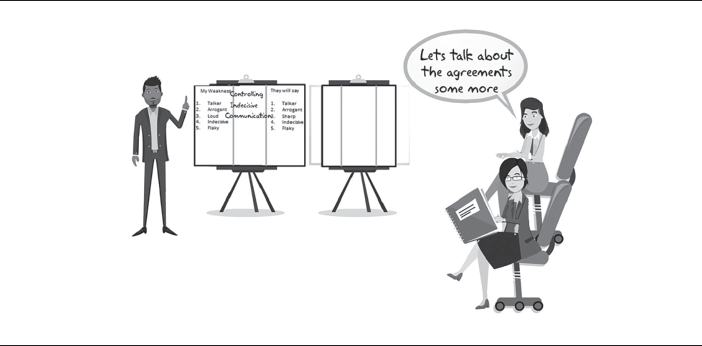
Step 5: The “So What”
Now that the analysis steps have been completed, the facilitator should work with the conflicting parties to generate some specific strategies for change. The root of the conflict will often be in the most offending behaviors identified in the eight and six assessments, and its resolution will be in how the two can support each other as allies rather than adversaries in their attempts to diminish these less than helpful behaviors. It is often the case that there is considerable agreement between the two parties in relation to areas of development (Figure 7-9).
It helps if the boss will actively accept the solutions and help both people live with the agreements made. To this end, sometimes we bring the boss of the two people in to participate in the analysis and add their views. This works well if you need the boss to hold people accountable for the details of the changes. But this could make it hard to get to the core of the conflict, especially if the boss is biased.
People are generally truthful in the first round of feedback (the eight strengths) because there is little conflict in doing so. There is often considerable similarity and agreement between them, which is both surprising to the two adversaries and gratifying to the facilitator.
| TOP TIP | Sometimes the person receiving the feedback will become defensive and maybe even argumentative. You can stop this by asking them to hold onto their opinions until you have seen all the items from both sides. But, it is your job as facilitator to act as the referee and not allow disagreement, because feedback is simply neutral information to be considered. |
Figure 7-9. The Root of the Conflict
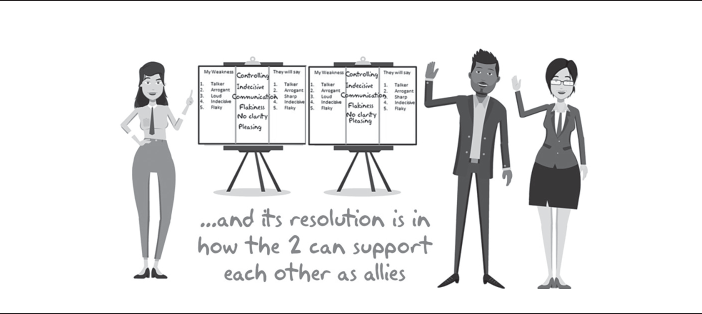
Our process leads individuals to be more candid about their own limitations for the second round (the six areas for development), because people do not want to be seen as lacking in courage about owning their weaknesses. The result is that when each looks at the other’s information, there are many areas of agreement. For example, if one person sees himself as sometimes being aggressive, he will likely find that the other person agrees. There is agreement on the problem (aggression), and that leads to the possibility of a mutual solution being developed.
This process also forces the behaviors identified as areas for development to be really specific, and this means that the potential solutions will also be specific. More often than not, the former adversaries decide together how to help each other be more effective, because both realize that their own success is being blocked by the behaviors they together identified and agreed on. Accountability to each other and possibly their boss makes the change real. The boss also has the authority to suggest that they expect positive changes to occur because the current situation is not acceptable. Thus, while the two participants usually, as part of their agreed strategy, meet to discuss their progress, the facilitator can continue meeting with them periodically over the next several months to support their commitment to change.
It is also possible for each participant to take an area of development and, with the help of their partner, undertake a 6-Step Problem Solving design, helping their partner in their analysis and eventual strategies.
Here is a summary of the steps with the timing for each.
| Step 1: The Setup | 15 Minutes (Before the Session) |
| Step 2: The Information Gathering | 30 Minutes |
| Step 3: The Strength Sharing | 60 Minutes |
| Step 4: The Development | 60 Minutes |
| Step 5: The “So What” | 30 Minutes |
| Total Design: | 3 Hours |
Paradox
Paradox (Figure 7-10) is a design used to train a working group in the use of paradoxical and creative thinking to look at problems in new, fresh ways. You’re doing what appears to be the opposite of what you intended to achieve your particular goal. It might sound strange, but this tactic can be very useful when you are trying to change a person’s predictable response to break a repeated behavior loop. This design can help a team generate new approaches to solving habitual behavioral problems with individuals or with the team itself.
It works because human beings like to function in habitual ways. Just as we can predict another person’s response to a given situation, we can also respond predictably to another’s behavior. Often when we are in conflict, this results in habitual responses on both sides and the same dissatisfied feelings over and over again. It can leave people feeling unheard or misunderstood. The good news is that we can use paradox to change both our response and other people’s responses.
Figure 7-10. Paradox

Step 1: The Setup
This design doesn’t need any physical setup; the only thing you will need to do is make sure the participants understand a few assumptions and have a basic grasp of paradoxical thinking. Let’s take an example of a team with 15 people. Divide them randomly into three groups of four and one group of three (Figure 7-11). These small groups will ensure a high level of participation.
Figure 7-11. The Setup
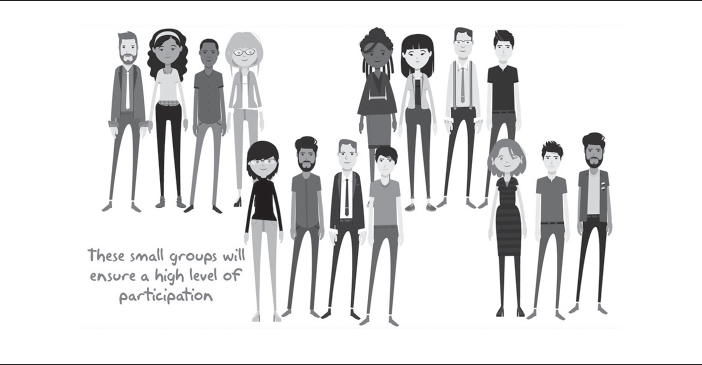
First, outline the following assumptions for the group to guide them in their thinking:
1. Any solution offered should not be seen as a punishment. This means you have to think about how the solution will be received and the consequences for the parties involved.
2. You’re talking about behavior, not about personality traits that cannot be changed. This is not therapy, simply a strategy for solving a perceived problem about how someone acts in predictable, often annoying, ways.
3. You are attempting to influence a behavior that may be part of a larger problem. Removal of the symptom—the repetitive, annoying, or dysfunctional behavior—is our goal, not fixing any larger problems that might exist. For example, someone may interrupt people. That would be the behavior, not the fact that the individual came from a family of individuals who never listened to them. Our goal is not to feel helpless in the face of such behavior.
4. Consider that often the problem is in our solution—that is, our response to the other person’s predictable behavior. Thus, if an individual is perpetually late and our response is to wait and be late with them as we boil inside, then the paradox to our waiting would be to leave and deal with a new reality (after a warning or two). Often we are so busy blaming the individual or being angry or annoyed that we fail to see other possible responses.
Now give the four chosen groups an example of paradox in action (Figure 7-12; you may change the details to fit your particular situation):
My husband leaves his clothes on the bedroom floor and I resent picking them up—but, predictably, I pick them up and end up nagging him. The paradox would be not to pick them up for a month and perhaps nicely suggest that we need to both be responsible for our own clothes. The problem will be whether I can stand the mess until my husband comes around to understanding. A nonparadoxical, but creative, response would be to let him know that all clothes found on the floor will cost him: $5 for socks, $10 for a shirt, and $8 for underwear. Again, the problem is often in our predictable solution to the problem. Picking the clothes up with no consequence was clearly my problem. Being willing to change my own behavior can solve the problem and also influence the other person.
Or there’s the story of eight-year-old Billy and his parents. They both work, so the one way they have family time is to all go shopping together on Saturdays. One day on returning home from shopping, the parents were putting away groceries and the father smelled something burning. He rushed into the living room and saw Billy lighting the drapes on fire. He yelled and scolded Billy, but this didn’t help; Billy lit four more fires in the next two weeks.
A therapist suggested that they paint a large metal oil barrel and put it at the end of his bed. Then every night for two weeks they were to build a small fire in it, sometimes singing campfire songs, roasting marshmallows, or telling stories.
After the fourth night, Billy said he didn’t want to do that anymore, but the parents told him they were having such a good time that they wanted to keep it up. By the sixth evening, Billy was hiding under a pillow at the other end of the bed.
Billy’s fire-setting was a symptom of the real issue. The therapist suggested that Billy simply wanted more attention, more fun with his family. The parents’ solution to not having enough time for Billy was to use shopping as his fun time, and this became the problem. It was an easy fix for the parents (combining doing the chores with spending time with Billy) but that left Billy feeling left out and not cared for. A little creativity solved the problem once the parents recognized that their actions were causing it.
Figure 7-12. Example Paradox

Step 2: The Directions
In the four small groups, have the participants share a number of situations they have with anyone at work or at home that drive them crazy. It should be aggravating, behaviorally defined, and predictable. Make sure they outline the following in their discussion:
1. What does the individual do (their behavior) that is predictable and annoying?
2. What is your and others’ response to the behavior? (predictable as well)
3. What is the outcome or consequence that is not helpful?
4. What is the specific behavior in the other that needs to change?
5. How does your behavior in response to the person’s behavior also appear to be predictable and part of the problem?
Tell participants that they have 20 minutes to share their situations together and pick one or two to share with the whole team.
Step 3: The Creative Response
After 20 minutes, get everybody back together in their small groups. Ask the first group to present one of their chosen predictable behaviors that demands a solution. Now give the other three working groups seven minutes to generate a creative, hopefully paradoxical solution for the consideration of the presenting group.
Have each working group in turn offer their creative solutions to the presenting group (Figure 7-13). Suddenly, they will have three or four interesting, creative, and, in some cases, paradoxical solutions to consider. Remember that the problem is often in our solution and is the trigger to more conflict. Our goal is to alter the predictable behavior of the other person with our creative solution and to change our own often-predictable response.
Figure 7-13. Creative Solutions

As the facilitator, comment about the creativity being generated because of the different way of looking at a problem. Make sure the solutions are not critiqued—the best ideas are usually obvious. If you can add perspective to a solution, do so.
Here is a summary of the steps with the timing for each.
| Step 1: The Setup | 20 Minutes |
| Step 2: The Directions | 30 Minutes |
| Step 3: The Creative Response | 20 Minutes |
| Total Design: | 70 Minutes |
Questions, Only Questions
Questions, Only Questions (Figure 7-14) is a wonderful design for unblocking a stuck team. We’ve all been there—experiencing that sinking feeling when the group we are leading is stalled or not functioning on all cylinders, but we can’t quite put our finger on the issue. What we do know is that there is tension in the group, that folks aren’t relating as they should—there is some kind of unfinished business within the group that appears to be impeding its productivity. Yet there hasn’t been any major blowup or crisis, no identifiable issue that shouts to be solved.
Figure 7-14. Questions, Only Questions

This design will give you a tool to “unstick” your team by helping the team members put their issues on the table, talk honestly without defensiveness, and speak the truth without recrimination—basically, to clear the air.
Step 1: The Setup
One of the best things about this design is that it can be used with little or no notice. No preparation is necessary—all you need is the realization that something is wrong and you should do something about it.
Once you have decided to use this design, the next thing to do is suggest to the group that you have an interesting process that will help move them forward. You can tell them you have done it before, and that it will be engaging and, yes, fun. Then give them these simple instructions:
1. Somebody will begin by asking another person on the team a question that, if answered, would help us explore what’s going on in this group.
2. The person receiving the question can only answer with another question—either back at the person asking the original question or at someone else, but it must be a question.
3. The question can be related to the first one asked or can raise a very different issue. It can be a direct, hard question such as, “Mary, what’s keeping us stuck?” or a softball, such as, “Is this making you nervous?” While the meeting participants might look confused, it’s actually very simple—and you can give the team a few examples to get them started, as you can see in Figures 7-15 and 7-16:
• Bill asks Mary, “Do you think we have unfinished business that is holding our team back?”
• Mary, instead of responding to Bill, asks Scott, “Do you think everyone is pulling their weight in the group?”
• Scott then asks Mary, “Have you noticed how fast some folks leave at 5 p.m.?”
• Mary then asks Ellen, “Are people free to give each other feedback in this group?”
• Ellen asks Scott, “Why would people not feel free to give feedback to someone in the group?” And so, the process continues.
By giving the sample questions, you are effectively setting a tone and direction for the group. Also ask them to be creative and honest in what they are asking. And remember, this is questions, only questions. We find people can get creative in their questions, such as, “Bill, don’t you think we are stuck because we never finished discussing the conflict Mary raised in the group last week?” Then Bill might ask Mary, “Is that true, Mary—how you feel about it?” Thus, a clever question can also be a powerful statement.
Step 2: Identifying the Issues
When you have gone around the team a few times (a lot of questions can be asked in 10 or 15 minutes) and have a pile of issues on the table, stop the process and create an opportunity to focus on some of the issues that have come up. You can put people into random groups of three and tell each cluster to agree on two or three issues that they need to discuss further and attempt to resolve. Or, you can just ask each person to decide on one or two issues that need to be addressed based on the questions and see where there is overlap in their thinking.
Step 3: The “So What”
Capture the issues that arise on flipchart paper, and then have an open discussion in relation to the top one or two only (Figure 7-17). Try to clarify the nature of these issues as best you can and collect ideas for possible solutions. Depending on the issues raised, the leap to solutions here can sometimes be a rather large step. If this is the case, you might want to consider using our 6-Step Problem Solving design at this point. If the issues are not too complex or contentious, you can simply hold an open (but time-limited) discussion with the group, after which next steps are outlined.
Figures 7-15 and 7-16. Sample Feedback Questions
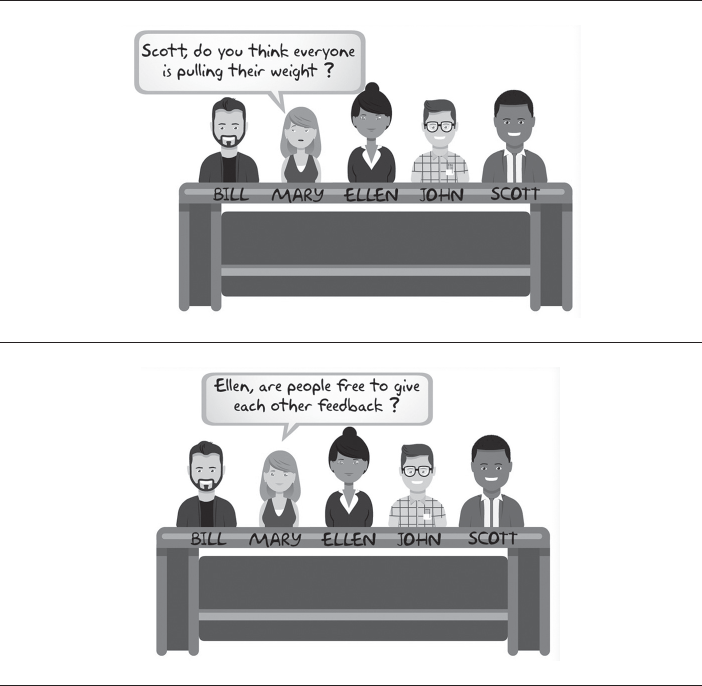
Figure 7-17. Discuss Top Issues
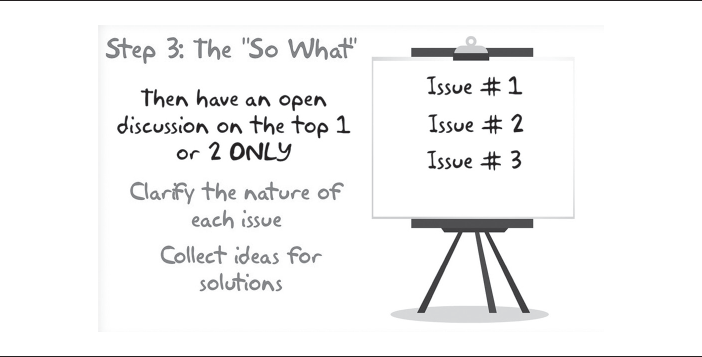
The questions provide a creative way to engage the team members and there’s usually a high level of participation. After all, if you are asked a question, you are obliged to ask one in return. Not only that, but behind most questions is an implied statement that needs a response. People tend to become direct very quickly, and patterns of questions tend to arise as the participants feel increasingly open.
Here is a of summary the steps with the timing for each.
| Step 1: The Setup | 10-30 Minutes |
| Step 2: Identifying the Issues | 5-10 Minutes |
| Step 3: The “So What” | 10-20 Minutes |
| Total Design: | 25-60 Minutes |
Speak Out
Speak Out (Figure 7-18), the final of our 13 designs, is helpful when dealing with differences between two groups—especially when those differences relate to how people feel treated in terms of ethnicity, race, religion, or gender. How people deal with such challenging issues means digging into the group’s culture and usually should not be addressed unless the group is ready to be honest with one another.
Figure 7-18. Speak Out

Imagine that someone on your team is feeling devalued, which is especially likely when they are in a subordinate position. In our example, it is the women on our team who are feeling devalued by a history of insensitive behavior toward them. Some of the strongly held team norms include don’t complain, never cry, stick with the task, and never waste time in the process of how things get done.
In this situation, discounting around gender had been bubbling under the surface for years, but one incident brought the issue to a head: A senior male officer made a highly prejudicial statement in a public meeting; a female counterpart then vigorously confronted him. The remaining women in the room exploded into clapping and laughter, while the men appeared to be in a state of confused silence.
| TOP TIP | Before getting into the design, remember to keep it simple. Don’t try and solve all the unfinished business in a single activity. Making any progress in such a touchy situation can usually be deemed a success, so let’s get creative. |
Step 1: The Setup
Invite the women of the team (in our example), or the person or group that needs to “speak out,” to a meeting and ask each person to develop a 10-minute story about their life—in this case, as a woman in today’s world. This means what they love about it, and what frustrates them, angers them, and leaves them feeling diminished. Encourage them to also talk about their experiences as children in their family with respect to the role that (in this case) gender played, and make sure they prepare one piece of advice for the men (or the other group) on the team that they believe will help diminish the issue in the future.
Step 2: The Sharing
Have each member of the “speak out” group share their stories at a deep level with the other women present (Figure 7-19).
Figure 7-19. Sharing Stories
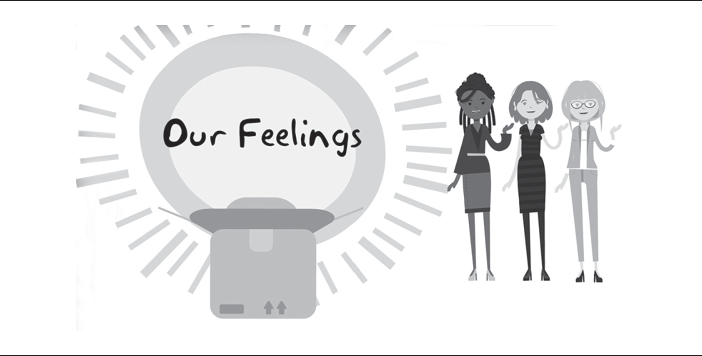
The reason for doing this is to ensure that each “speak out” group member is committed to being honest and to supporting one another as they share their ideas without holding back. For people who usually keep these feelings to themselves, it can be a huge catharsis as each one reveals their strongest feelings, and they are all vulnerable together. It’s important that there is no debate, no questioning of each individual’s comment other than for clarification.
Step 3: The Big Meeting Invite
After people have shared personal histories and feelings around the issue, arrange a meeting with the whole team (in this case, the men and the women) and set it up as an opportunity to share at a deep level the feelings and history triggered during the incident. The men will probably think that it will be a confrontational meeting with them being the bad guys—but that could not be further from the truth, so try to let them know this. For them, it will primarily be about listening deeply to their female associates and helping the women feel heard.
Step 4: The Positioning
Set the room up with the women sitting together in a semicircle facing the men. Then give the following instructions to the men: These women, their colleagues, have each been asked to share their stories of what it is to be a woman in today’s world (Figure 7-20). Each will have up to 10 minutes, and they promise to be honest and specific in the stories and examples they are going to share. As colleagues, they need to understand this history because it has an impact of which they have little understanding. It is not about blame, but about gaining a new understanding of this powerful and unspoken reality. The men’s job is to listen deeply and to be open to learning, because later they will be asked to share what they have heard and any feelings they have about it. This is not a debate and it is not about right or wrong.
Figure 7-20. Listen and Learn

Step 5: The “So What”
At the end of the sharing, and after a brief break, have the male members of the team share what they just heard from their female counterparts. Then lead the group in a discussion relating to what this means for them as a team.
The key to this design is to place the men in a noncombative situation, knowing that their responsibility is to listen deeply. For the women, there has to be a commitment to be honest at both an intellectual and emotional level and awareness that they will, as a group, have to be vulnerable. Knowing beforehand that they are aligned with the other women gives the female participants the courage to share their stories in very personal and dramatic ways.
As the design unfolds, the men will begin to hear a reality that they have likely never heard before and understand how this influences their work and their relationships on the team. Again, there is no win-lose aspect to this design, because the focus on both sides is on understanding.
As a follow-up to this design, you might want to arrange another meeting for more in-depth problem solving. A design such as 6-Step Problem Solving would be a good one to generate more detailed strategies for change. Again, you are not expected to solve such an intractable problem. But deep listening is a good beginning. Most likely there are real solutions in the group that a discussion like this can ignite (Figure 7-21).
Figure 7-21. Discussion

It might also be very powerful, at another time, to have the men undertake their own speak-out, because a large part of the problem of gender differences rests in how the men live with huge expectations about what it is to be a man in our society and how that influences their behavior. Once this is done, problem solving in relation to how to establish different “rules of engagement” between men and women on the team or in the organization can be explored with both candor and care.
Here is a summary of the steps with the timing for each.
| Step 1: The Setup | 10 Minutes |
| Step 2: The Sharing | 50 Minutes |
| Step 3: The Big Meeting Invite | 30 Minutes* |
| Step 4: The Positioning | 60 Minutes |
| Step 5: The “So What” | 30 Minutes |
| Total Design: | 2.5 Hours |
(*between the two face-to-face sessions to set up a meeting invite and proposal with the attendees) |
|
In this chapter, we have shown you four designs dealing with individual or team conflict, with common threads to them. For example, these designs will also help with developing problem-solving skills. The very act of experiencing them will improve the team’s communication skills and willingness to speak up. As a result of using these designs, you will also be team building by both dealing with the team’s issues (conflict) and engaging the brainpower of the whole team to do this.
Doing nothing is the solution of choice for many teams, so problems tend to fester and keep them from becoming a truly high-performing team. We believe this book, with the focus on intentional facilitation and the use of creative designs, will provide you with a new way of thinking and acting as you attempt to improve your team.
